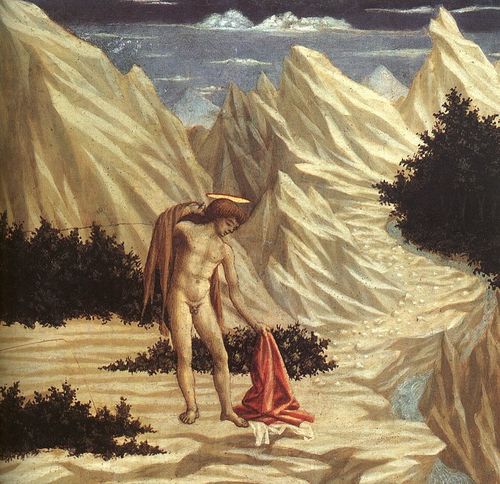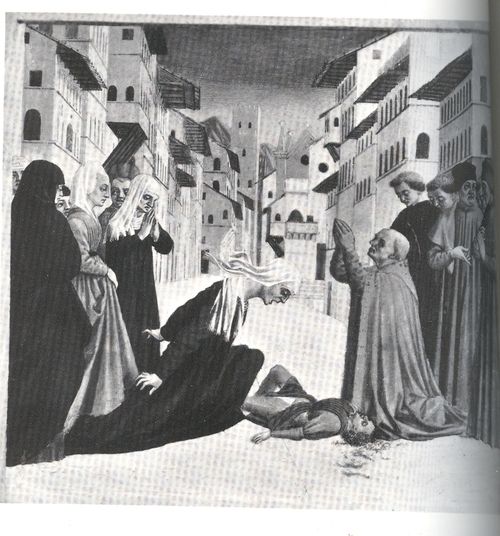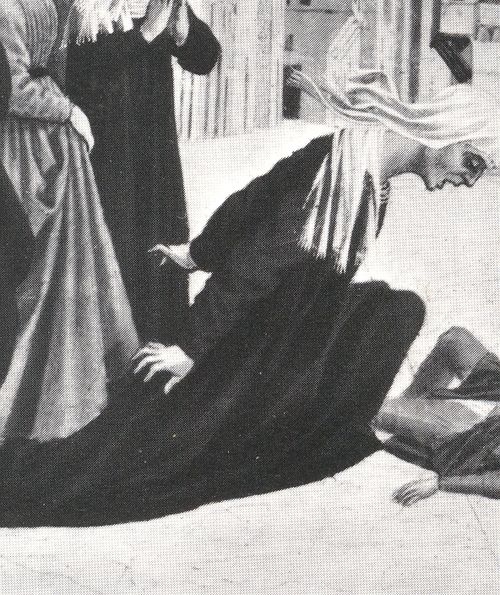JF Ptak Science Books Post 613 Blog Bookstore
When considering the alphabet of emotions displayed in Italian Renaissance art, it seems to me that Horror and Despondency seem not to appear very often. (Again, this is for the Italians--not the northern Renaissance.) This flimsy conclusion may be of my very own not-very-well exposed weakness and may be fantastically wrong---well, I think the odds are more in the favor of this being modestly wrong rather than fantastically so. This inspiration took hold when looking at an uncommonly-reproduced work by Domenico Veneziano (b. Venice, ca. 1400 and dying in Florence in 1461) displaying a posture and an emotion that I have seldom seen. I am a little familiar with Veneziano--having lived in Washington DC for 29 years I visited the National Gallery many many times, and themiddle point of the visit was almost always at Veneziano's fantastic and weird St John in the Desert (ca. 1445) or with his St. Francis Receiving His Stigmata. (There are more examples of his work in the Continued Reading section below.) But this image was new to me and astonishing--it is the Resurrection of the Child , and the painting's main character, the mother of the injured child, displays a character of grief and body language that is singular to my experience. (The image appears in James Ackerman's superb Distance Points, Essays in Theory and Renaissance Art and Architecture (MIT, 1991, p. 86)
When I think of all of the Pietas (by Botticelli, Raffaellino de Gardo, Berruguete) I cannot recall seeing this level of grief, or horror, or terror; or curling fingers in the deepest base of despondency in the features of Mary or just about anyone else. Actually, Carol Crivell approaches this sort of emotion, but it seems fairly scarce in the history of Renaissance Pietas. Rending scenes of the dead and bleeding Christ, and rape scenes, lamentations, still do not approach this sort of expression as we can see in Perugino's Lamentations and Cruxifiction, Antonello Messina's Rape of Helen,andCarpaccio's Meditation on the Dead Christ.
There are occasions when St. George shows some real fear and horror (Cosimo Tura's St. George), and mothers are spectacularly despondent over the killing of their babies (Matteo di Giovanni Massacre of the Innocents), but to me the myriad of images showing the Temptations of St. Anthony and the ravages of time and the seven deadly sins and on and on, just, really, never come quite to this level of terror in Veneziano. I'm probably off base with this, but honestly, the contrasting pull of the mother's body both lunging forward and pulling backwards, the enormous passion of her face, the curling fingers, are almost too much to bear. You can hear her scream as her body works against itself, pulling her apart. And when comparing Veneziano's Resuscitation with others in this genre--Ghiberti's child being brought back to life by St. Francis, Lippi's Drusiana by St. John the Evangelist, for example--this deepest of all expressions of horror isn't there. I imagine that the other images of terror and horror are wrapped in Holy cloth and Infinite Wisdoms, these people being saints and all, but when it comes right down to mortals and losing their children, there's no room for holiness, and Veneziano allows the truth of the emotion to come pouring out.
 |
Madonna and Child. c. 1437-38. Tempera on wood. 73.2 x 53.2 cm. Art Museum, Bucharest, Romania. |
 |
The Adoration of the Magi. c. 1439-41. Poplar, diameter 84 cm. Gemäldegalerie, Berlin, Germany. |
 |
St. Francis Receiving the Stigmata. c. 1445. Wood. 26.7 x 30.5 cm. The National Gallery of Art, Washington, DC, USA. |
 |
Madonna and Child. c. 1445. Tempera on wood. 83 x 57 cm. The National Gallery of Art, Washington, DC, USA. |
 |
The Madonna and Child Enthroned with SS. Francis, John the Baptist, Zenobius and Lucy. The main part of the Altarpiece of St. Lucy of the Magnolias. 1445-47. Tempera on wood panel. 209 x 216. Galleria degli Uffizi, Florence, Italy. . |
 |
The Martyrdom of St. Lucy. c. 1445-48. poplar. 26.5 x 29.5 cm. Predela panel of the Altarpiece of St. Lucy of the Magnolias. Gemäldegalerie, Berlin, Germany. |
 |
St. John the Baptist and St. Francis. Detached fresco. 190 x 115 cm. 1455-1460. Museo dell'Opera di Santa Croce, Florence, Italy. |
 |
Portrait of a Young Woman. c. 1465. tempera on wood. 52.5 x 36.5 cm. Gemäldegalerie, Berlin, Germany. |






Comments